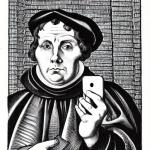Martin Bernal (Black Athena, 1.128) points out the novelty of Christian association with the sign of the fish, which had no purchase in the Old Testament: “Key disciples were fishermen, and fishing images abound. There is the miracle of the two fishes and the five loaves of bread. Even more strikingly, in the Gospel according to St John, Christ gave his disciples fish in a symbolic last meal. This theme, and the idea that fish were central to the Last Supper, were standard in early Christian iconography. In the sense of transubstantiation, Christ was not merely bread or grain like Osiris, he was a fish or – as was equally often represented – two fishes. As Tertullian, the brilliant early Christian thinker, wrote around the year 200: ‘We little fishes, after the image of our Ichthys . . . are born in the water.”
It was an astrologically appropriate sign. Jews weren’t the only millennarians in the first two centuries AD. Romans also believed that a new age was dawning, marked by the stars, in the change from the age of Aries to the age of Pisces, from the ram to the fish. Bernal sees a similar astrological significance behind Virgil’s famous Fourth Eclogue: “the poet – as a poet – employed several different levels of meaning: the birth of Pollio’s child; the beginning of a peaceful age under his and Pollio’s patron, Augustus. The words also seem to indicate the coming of a new young divinity. They certainly refer to a cosmic or astral change of age, which can only be the new age of Pisces” (126).















